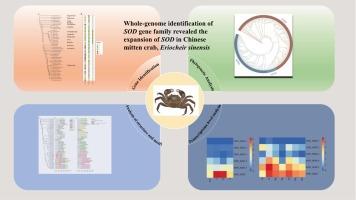Whole-genome identification of SOD gene family revealed the expansion of SOD in Chinese mitten crab, Eriocheir sinensis
IF 2.2
2区 生物学
Q4 BIOCHEMISTRY & MOLECULAR BIOLOGY
Comparative Biochemistry and Physiology D-Genomics & Proteomics
Pub Date : 2025-08-27
DOI:10.1016/j.cbd.2025.101618
引用次数: 0
Abstract
Superoxide dismutase (SOD) genes are essential components of the antioxidant defense system in crustacean. However, SOD genes have not been identified in Chinese mitten crab (Eriocheir sinensis). In this study, 6 SOD genes including 5 SOD1 and 1 SOD2 genes were identified through a comparative analysis in E. sinensis. Phylogenetic analysis clustered all SODs including outgroups into three groups: SOD1, SOD2, and SOD3. Among these three groups, SOD1 exhibited the highest number of genes, followed by SOD2. Chromosomal mapping revealed that SOD1.1, SOD1.2, SOD1.4, SOD1.5 and SOD2 were located on chromosomes (Chr52, Chr7, Chr41 and Chr19), while SOD1.3 was distributed on scaffolds. Sequence characteristics analyses revealed that SOD1 and SOD2 had large sequence differences and different structure domain. Transcriptomic profiling showed tissue-specific expression patterns, with SOD2 and SOD1.5 highly expressed in the gill. In addition, SOD2 exhibited a high expression level during the intermolt (stage C), pre-molt (stage D). These findings suggest that SOD2 may play critical roles in oxidative stress management and molting regulation, providing valuable insights into the antioxidant mechanisms of crustaceans.

SOD基因家族的全基因组鉴定揭示了中华绒螯蟹(Eriocheir sinensis)中SOD的扩增
超氧化物歧化酶(SOD)基因是甲壳类动物抗氧化防御系统的重要组成部分。然而,在中华绒螯蟹(Eriocheir sinensis)中尚未发现SOD基因。本研究通过对比分析,在中华绒螯蟹中鉴定出6个SOD基因,其中SOD1基因5个,SOD2基因1个。系统发育分析将包括外群在内的所有sod聚类为SOD1、SOD2和SOD3三组。三组中SOD1基因数量最多,SOD2次之。染色体图谱显示,SOD1.1、SOD1.2、SOD1.4、SOD1.5和SOD2位于Chr52、Chr7、Chr41和Chr19染色体上,SOD1.3分布在支架上。序列特征分析表明,SOD1和SOD2具有较大的序列差异和不同的结构域。转录组学分析显示了组织特异性表达模式,SOD2和SOD1.5在鳃中高度表达。此外,SOD2在蜕皮间期(C期)和蜕皮前期(D期)表现出高表达水平。这些发现表明SOD2可能在氧化应激管理和换壳调节中发挥关键作用,为甲壳类动物的抗氧化机制提供了有价值的见解。
本文章由计算机程序翻译,如有差异,请以英文原文为准。
求助全文
约1分钟内获得全文
求助全文
来源期刊
CiteScore
5.10
自引率
3.30%
发文量
69
审稿时长
33 days
期刊介绍:
Comparative Biochemistry & Physiology (CBP) publishes papers in comparative, environmental and evolutionary physiology.
Part D: Genomics and Proteomics (CBPD), focuses on “omics” approaches to physiology, including comparative and functional genomics, metagenomics, transcriptomics, proteomics, metabolomics, and lipidomics. Most studies employ “omics” and/or system biology to test specific hypotheses about molecular and biochemical mechanisms underlying physiological responses to the environment. We encourage papers that address fundamental questions in comparative physiology and biochemistry rather than studies with a focus that is purely technical, methodological or descriptive in nature.

 求助内容:
求助内容: 应助结果提醒方式:
应助结果提醒方式:


